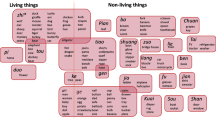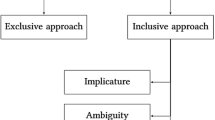Abstract
In the present study, we tested claims by Lucy (1992a, 1992b) that differences between the number marking systems used by Yucatec Maya and English lead speakers of these languages to differentially attend to either the material composition or the shape of objects. In order to evaluate Lucy's hypothesis, we replicated his critical object classification experiment using speakers of English and Japanese, a language with a number marking system very similar to that employed by Yucatec Maya. Our results failed to replicate Lucy's findings. Both Japanese and English speakers, who were comparable in their cultural and educational backgrounds, classified objects more on the basis of shape than material composition, suggesting that Lucy's original findings may have resulted not from differences between the number marking systems of Yucatec Maya and English but rather from differences in the cultural and educational backgrounds of his experimental groups. Alternative accounts of the cognitive consequences of inter-linguistic differences in number marking systems are discussed.
Similar content being viewed by others
REFERENCES
Au, Terry K. (1983) “Chinese and English Counterfactuals: the Sapir-Whorf Hypothesis Revisited,” Cognition 15, 155–187.
Berlin, Brent, and Paul Kay (1969) Basic Color Terms: Their Universality and Evolution, University of California Press, Berkeley.
Brian, Clara R., and Florence L. Goodenough (1929) “The Relative Potency of Color and Form Perception at Various Ages,” Journal of Experimental Psychology 12, 197–213.
Bowerman, Melissa (1996) “The Origins of Children's Spatial Semantic Categories: Cognitive Versus Linguistic Determinants,” in J. J. Gumpertz and S. C. Levinson (eds.), Rethinking Linguistic Relativity, Cambridge University Press, New York, pp. 145–176.
Brown, Roger W., and Eric H. Lenneberg (1954) “A Study in Language and Cognition,” Journal of Abnormal and Social Psychology 49, 454–462.
Carroll, John B., and Joseph B. Casagrande (1958) “The Function of Language Classifications in Behavior,” in E. A. Maccoby, T. M. Newcomb and E. L. Hartley (eds.), Readings in Social Psychology, 3rd Edition, Holt, Reinhart and Winston, New York.
Comrie, Bernard (1990) “Introduction,” in B. Comrie (ed.), The World's Major Languages, Oxford University Press, New York, pp. 1–30.
Chierchia, Gennaro (1994) “Syntactic Bootstrapping and the Acquisition of Noun Meanings: The Mass-Count Issue,” in B. Lust, M. Suner and J. Whitman (eds.), Syntactic Theory and First Language Acquisition, Vol. 1: Heads, Projections, and Learnability, Erlbaum, Hillsdale, New Jersey, pp. 301–318.
Choi, Soonja, and Melissa Bowerman (1991) “Learning to Express Motion Events in English and Korean: The Influence of Language-Specific Lexicalization Patterns,” Cognition 41, 83–121.
Clark, Herbert (1973) “Language-as-Fixed-Effect Fallacy,” Journal of Verbal Learning and Verbal Behavior 12, 335–359.
Corah, Norman L. (1966) “The Influence of Some Stimulus Characteristics on Color and Form Perception in Nursery School Children,” Child Development 37, 205–211.
Doehring, Donald G. (1960) “Color-Form Attitudes of Deaf Children,” Journal of Speech and Hearing Research 3, 242–248.
Greenfield, Patricia M., Lee C. Reich, and Rose R. Oliver (1996) “On Culture and Equivalence (Part 2),” in J. S. Bruner, R. R. Oliver, and P. M. Greenfield (eds.), Studies in Cognitive Growth, Wiley, New York.
Gumpertz, John J., and Stephen C. Levinson (1996) (eds) Rethinking Linguistic Relativity, Cambridge University Press, New York.
Heider, Eleanor R. (1972) “Universals in Color Naming and Memory,” Journal of Experimental Psychology 93, 10–20.
Heider, Eleanor R., and D. C. Oliber “The Structure of the Color Space in Naming and Memory for Two Languages,” Cognitive Psychology 3, 337–354.
Hoosain, Rumjahn (1991) Psycholinguistic Implications for Linguistic Relativity: A Case Study of Chinese, Erlbaum, Hillsdale, New Jersey.
Hunt, Earl, and Franca Agnoli (1991) “The Whorfian Hypothesis: A Cognitive Psychology Perspective,” Psychological Review 98, 377–389.
Imai, Mutsumi (in press) “Universal Ontological Knowledge and a Bias Toward Language-Specific Categories in the Construal of Individuation,” in S. Niemeier and B.R. Dirven (eds.), Evidence for Linguistic Relativity, John Benjamins, Amsterdam.
Imai, Mutsumi, and Dedre Gentner (1997) “A Cross-Linguistic Study of Early Word Meaning: Universal Ontology and Linguistic Influence,” Cognition 62, 169–200.
Imai, Mutsumi, and Reiko Mazuka (1997) “A Cross-Linguistic Study on the Effects of Individuation in Linguistic and Non-Linguistic Contexts,” poster presented at biennial meeting of Society for Research in Child Development, Washington DC, 1997.
Johnston, Judith R., and Dan I. Slobin (1979) “The Development of Locative Expressions in English, Italian, Serbo-Croatian and Turkish,” Journal of Child Language 6, 529–545.
Keil, Frank C. (1989) Concepts, Kinds, and Cognitive Development, MIT Press, Cambridge, Massachusetts.
Lenneberg, Eric H., and J.M. Roberts (1956) “The Language of Experience: A Study in Methodology,” International Journal of American Linguistics 22 (2, part 2, Memoir 13).
Lucy, John. A. (1992a) Linguistic Diversity and Thought, Cambridge University Press, New York.
Lucy, John. A. (1992b) Grammatical Categories and Cognition, Cambridge University Press, New York.
Rosch, Eleanor (1973) “On the Internal Structure of Perceptual and Semantic Categories,” in T. E. Moore (ed.), Cognitive Development and the Acquisition of Language, Academic Press, New York, pp. 111–157.
Rosch, Eleanor, Carolyn Mervis, Wayne Gray, David Johnson, and Penny Boyes-Braem (1976) “Basic Objects in Natural Categories,” Cognitive Psychology 8, 153–169.
Serpell, Robert (1969a) “The Influence of Language, Education and Culture on Attentional Preference Between Color and Form,” International Journal of psychology 4, 183–194.
Serpell, Robert (1969b) “Cultural Differences in Attentional Preference for Color Over Form,” International Journal of Psychology 4, 1–8.
Slobin, Dan I. (1996) “From Thought and Language to Thinking for Speaking,” in J. J. Gumpertz and S. C. Levinson (eds.), Rethinking Linguistic Relativity, Cambridge University Press, New York, pp. 70–96.
Soja, Nancy N., Susan Carey, and Elizabeth S. Spelke (1991) “Ontological Categories Guide Young Children's Inductions of Word Meaning: Object Terms and Substance Term,” Cognition 38, 179–211.
Suchman, Rosslyn G. (1966) “Cultural Differences in Children's Color and Form Preferences,” Journal of Social Psychology 70, 3–10.
Suchman, Rosslyn G., and Tom Trabasso (1966) “Color and Form Preference in Young Children,” Journal of Experimental Child Psychology 3, 177–187.
Whorf, Benjamin L. (1956) Language, Thought, and Reality: Selected Writings of Benjamin Lee Whorf (ed., J. B. Carroll), MIT Press, Cambridge, Massachusetts.
Winer, B. (1971) Statistical Principles in Experimental Design (2nd ed.), McGraw-Hill, New York.
Zhang, Shi, and Bernd Schmitt (1998) “Language-Dependent Classification: The Mental Representation of Classifiers in Cognition, Memory and Evaluations,” Journal of Experimental Psychology: Applied 4, 375–385.
Author information
Authors and Affiliations
Rights and permissions
About this article
Cite this article
Mazuka, R., Friedman, R.S. Linguistic Relativity in Japanese and English: Is Language the Primary Determinant in Object Classification?. Journal of East Asian Linguistics 9, 353–377 (2000). https://doi.org/10.1023/A:1008356620617
Issue Date:
DOI: https://doi.org/10.1023/A:1008356620617




